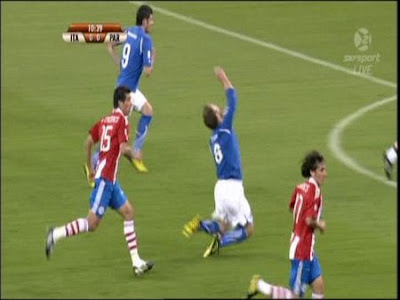Somebody alert Daniele De Rossi’s family. He’s going to need to be airlifted to the nearest medical facility for immediate assessment.









No, wait, he’s fine.

The captain went through some pain of his own, but he too bounced back.





Now I don’t offer any of this in order to trot out the well-known clichés about Italian theatrics on the football field. What I think these images demonstrate is rather how expressive we are, especially when it comes to showing pain. We are not a stoic people. We do not repress our negative emotions. We carry a long history of suffering in our bodies and on our faces, and are not afraid to show it.
It seems to be a constant of Italy at the world cup that we should struggle in the first round, that we have to - it’s the actual word used - suffer. We didn’t in 2006, as a matter of fact, but this hasn't prevented the media coverage in the lead up to the game against Paraguay to be all about Italy and suffering in the early stages. On the evidence of today’s game, it’s set to happen again. So expect more intense close-ups and the kind of nervy lunging of bodies that would have caused Michelangelo to reach in haste for his sketchbook.
Excellent stuff. A welcome return to world football for the full beard too....that plus the mad eyes make De Rossi look almost Oliver Reed-esque.
ReplyDeleteThat Cannavaro injury looked as if it might have been really bad, though - it initally looked like a nasty twist.
ReplyDeleteIt's the lack of stoicism that makes the Italy team so gripping to watch - they are capable of the same gloomy self-doubt as England, but they are much more capable than England of stirring themselves out of it. You could practically see that happening in the 2006 tournament in the game against Australia.
The Cannavaro episode was a bit comical I thought. He got his arm pulled, then he lost his balance, propped himself on it by reflex and recoiled in pain only to land on his arse and yes, possibly twist his right knee a little bit.
ReplyDeletesorry, but for me it's evident that you haven't played football for a while. hence the irony. these fall-downs look really nasty. i have recently injured myself this way without really being touched by anyone from opposite team. still, interesting remarks...
ReplyDeleteI'm not saying that any of that wasn't painful. (Although how being clipped on the ankle sends you hurtling upwards with your arms up in the air isn't very clear, from a strictly physiological point of view.) What I was commenting on was the unhinibitedness of these gestures.
ReplyDelete@ Piotr
ReplyDeleteDidn't see Cannavaro's but the pics look painful
Saw De Rossi and it was a dive. There was an excellent study done recently comparing body language between simulated dives and unsimulated falls/trips. The two recurring features seen in the players asked to dive were the arched back and the arms flung skyward - a genuine fall looks completely different, your arms come out involuntarily to break your fall, not plead to some cosmic footballing God of Justice.
yeah, I know. i'm just a bit tired of suggesting that every gesture of pain is made up - the cliche that you mentioned. of course it's not exactly case of your post.
ReplyDelete@ Piotr and ps, i play weekly
ReplyDeleteok, guys, sorry for being a classic troll for a second :> btw i'd really like to see/read this study. yeah and Cannavaro's fall really does look awful. btw some great posts so far.
ReplyDeleteI'm not saying it's made up either - I'm saying it's coded differently. And this coding has cultural roots that run deeper than the professional footballing practice.
ReplyDeleteI shall expand on this at some stage (not here, I promise!) but it's worth making a passing mention to the figure of the prefiche, women in the South of Italy whose job it was to cry at the funerals of strangers. This is not to say that Southern Italians felt the pain of grieving for a relative more deeply than their more reserved counterparts in the North or in other countries; just that the outward display of pain is partly a social construct, and it can differ markedly from nation to nation.
I appreciate that telling when somebody is simulating pain altogether is important in sports, but different cultural inflections come into it and they need to be acknowledged.
So, to the point that zone_styx makes: De Rossi both wasn't a dive - if you look at the slow-mo replay, he was clipped, it just took him another half step to feel it - and was a dive, in the sense that the way in which he fell wasn't a straightforward physiological response to the foul. But then, without wanting to be silly about it, how do you disambiguate the physiological response from the cultural response?
ReplyDeleteI guess some of these gestures can be a way to have a rest and not look stupid *just laying there*
ReplyDelete@ piotr - hardly trolling!
ReplyDeletethe study is here
http://www.springerlink.com/content/k6341643l8p47720/
and its contents are described here under 'detection' (wikipedia i'm afraid but seems credible)
http://en.wikipedia.org/wiki/Diving_%28football%29